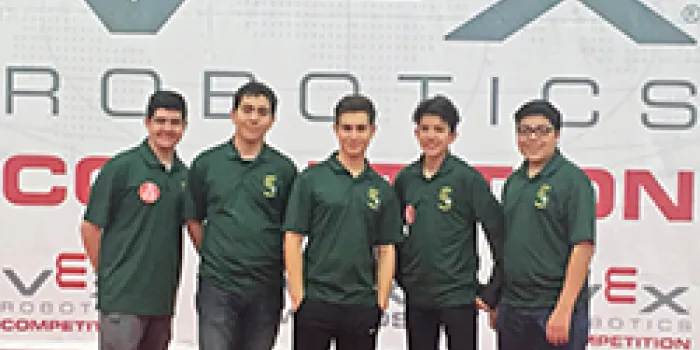In each issue of HemAware, we spotlight a member of the bleeding disorders community. This issue, we profile Federico Parres.
Federico Parres is a sophomore at Damien High School in LaVerne, California. He has severe hemophilia A and is part of Team F, which has taken Caerus-7, a ball-flinging robot, to the VEX Robotics World Championship in Louisville, Kentucky.
VEX Robotics Competitions, which are operated by the educational nonprofit Robotics Education & Competition Foundation (REC), are tournaments in which teams of students design and build a robot, which is then entered into a series of competitions. Parres’ team competed in the 2015-16 VEX High School Robotics Tournament.
Parres’ team consists of five members, all but one of whom are sophomores. They divide the responsibilities of Caerus-7 as follows: Parres is the programmer and on-field operator; his teammate Eren is the chief engineer, who builds the robot and troubleshoots mechanical issues. Jason assists with ammunition and making sure the robot fires properly. Lorenzo is the on-field manager who supplies tactical information during competition. Adrian is in charge of research and reconnaissance.
If that sounds military, rest assured that Caerus-7 is designed simply to throw balls at a net. Each year in April, VEX announces what the competition will be for the upcoming tournaments. The students then design a robot to execute the task. The game for the 2015-16 season was “Nothing but Net,” which Parres describes as “robot basketball.”
“There’s a 12’ x 12’ field with two nets on it, and stacks of balls. The robot needs to be able to fire the balls into the nets,” Parres says. Points are given based on how many balls go into a net and where they hit.
For the VEX Robotics Competition, teams go head to head in a series of local, state and regional events, all of which culminate in the VEX Robotics World Championship. Team F competed in several of VEX’s regional competitions, and won the Excellence Award at one of them. “That’s the highest honor you can win there,” says Parres. “Since it was, for our team, the first year of doing robotics, it was a really amazing achievement for us.” This win, plus one other regional win, qualified Team F for the US Open National Championship and the World Championship.
After a multitude of technical difficulties at the nationals, Team F took the week before the World Competition to revamp elements of their robot. “When we got to the World Championship we did quite well,” Parres says. “We went from 100th up to 37th place. We called it the World’s Greatest Comeback.”
“When I was younger, I wanted to be an astronaut, but quickly realized that hemophilia and space travel isn’t a good combination,” says Parres. His interests in science, math, programming and space have led him to decide to pursue aerospace engineering when he’s in college.
“I wanted to be an inventor when I was a kid,” he says. “Then I realized there’s a better word for inventor—it’s engineer.”

